|
Printables |
PowerPoints |
Online exercises |
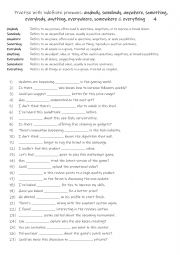
|
A2-B1 Practise with indefinite pronouns anybody, somebody, anywhere, something, everybody, anything, everywhere, somewhere & everything 4
First, students need to familiarise themselves with the 9 indefinite pronouns and their meanings and use. Then they read the sentences to work out which one is needed to complete the gap-fill. Each word is used 3 times! Answers on page 2
Level: elementary
Age: 8-100
Type:
Downloads: 111
|
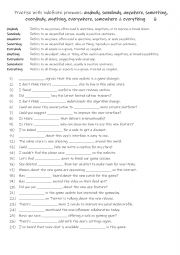
|
A2-B1 Practise with indefinite pronouns anybody, somebody, anywhere, something, everybody, anything, everywhere, somewhere & everything 6
Learning indefinite pronouns like anybody, somebody, anywhere, something, everybody, anything, everywhere, somewhere, and everything is essential for students to express general ideas or refer to non-specific people, places, or things. These pronouns are commonly used in everyday communication to ask questions (e.g., "Is there anybody here?"), make...
Level: elementary
Age: 9-100
Type:
Downloads: 114
|
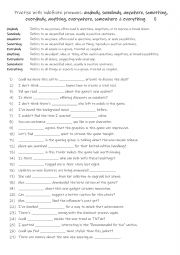
|
A2-B1 Practise with indefinite pronouns anybody, somebody, anywhere, something, everybody, anything, everywhere, somewhere & everything 5
First, students need to familiarise themselves with the 9 indefinite pronouns and their meanings and use. Then they read the sentences to work out which one is needed to complete the gap-fill. Each word is used 3 times! Answers on page 2
Level: elementary
Age: 8-100
Type:
Downloads: 103
|
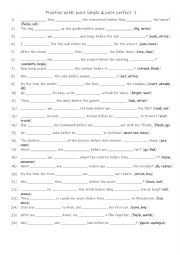
|
A2-B1 Practise with past simple & past perfect 1
Students should learn the past simple and past perfect because they are essential for discussing events in the past with clarity and accuracy. The past simple is used to describe completed actions or events that happened at a specific time (e.g., "She travelled to France last summer"), making it crucial for storytelling and recounting past experien...
Level: intermediate
Age: 10-100
Type:
Downloads: 117
|
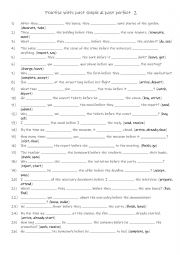
|
A2-B1 Practise with past simple & past perfect 2
First, students need to familiarise themselves with the 2 tenses and their use. Then they read the sentences to see which tense is required to complete the gap-fill using the given infinitive in (). Each tense is used 13 times! Answers on page 2.
Level: intermediate
Age: 9-100
Type:
Downloads: 115
|

|
A2-B1 Practise with present continuous or past continuous passive voice 3
These tenses enhance precision and fluency when talking about the future. First, students need to familiarise themselves with the 2 tenses and their use. Then they read the sentences to work out which one is needed to complete the gap-fill. Each adverb is used 13 times! Answers on page 2
Level: elementary
Age: 10-100
Type:
Downloads: 119
|
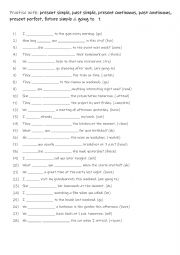
|
A2-B1 Practise with present simple, past simple, present continuous, past continuous, present perfect, future simple & going to 1
Students should practice the Present Simple, Past Simple, Present Continuous, Past Continuous, Present Perfect, Future Simple, and "Going to" tenses because these are fundamental to expressing a wide range of ideas in English. Mastering these tenses allows students to describe habits, routines, actions in progress, past events, completed actions, f...
Level: intermediate
Age: 8-100
Type:
Downloads: 124
|
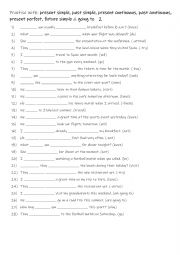
|
A2-B1 Practise with present simple, past simple, present continuous, past continuous, present perfect, future simple & going to 2
First, students need to familiarise themselves with the tenses and use. Then they read the sentences to work out which one is needed to complete the gap-fill using the infinitive in (). Each tense is used 3 times! Answers on page 2
Level: elementary
Age: 9-100
Type:
Downloads: 121
|
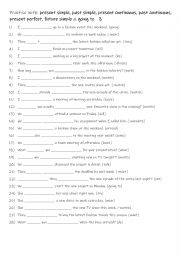
|
A2-B1 Practise with present simple, past simple, present continuous, past continuous, present perfect, future simple & going to 3
Practising these tenses allows students to speak confidently about everyday situations, past events, future plans, and hypothetical scenarios. It improves their ability to communicate with precision, enhances fluency, and prepares them for more advanced grammar. Mastery of these structures supports clearer expression of ideas and better understandi...
Level: elementary
Age: 8-100
Type: worksheet
Downloads: 152
|
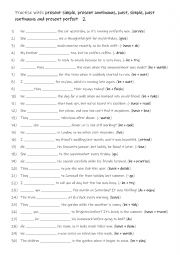
|
A2-B1 Practise with present simple, present continuous, past, simple, past continuous and present perfect 2
First, students need to familiarise themselves with the 5 tenses and their use. Then they read the sentences to see which one is needed to complete the sentence using the given infinitive in (). Each tense is used 6 times! Answers on page 2.
Level: elementary
Age: 9-100
Type:
Downloads: 124
|
|
|
|
|












